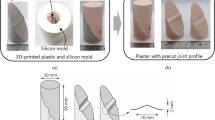Abstract
A low-speed drum camera has been used to continuously record the strain profile in several different types of impact tests. The drum camera was selected because it is inexpensive and simple to use, and it overcomes many of the inherent disadvantages of other dynamic-recording techniques.
The use of the drum camera in recording the strain profile in tensile and torsional impact is illustrated, as well as the determination of impact velocity in collinear plastic impact of two bars. A detailed discussion of determination of the strain profile from the tensile-test film record is presented, including an analysis of the accuracy achieved. It was found that the drum camera is capable of measuring strains to an accuracy of approximately 1 percent for a gage length of 0.05 in. Strains varying from 1 to 100 percent were measured in the tensile test, with a nominal strain rate of 20 sec−1. Strain rates of up to 2000 sec−1 were successfully recorded in the torsional impact tests.
Similar content being viewed by others
References
Austin, A. L. and Steidel, R. F., “A Method for Determining the Tensile Properties of Metals at High Rates of Strain”, Proc. SESA XVII (1), 99–114 (1958).
Bell, J. F., “Determination of Dynamic Plastic Strain through the Use of Diffraction Grantings”,Jnl. Appl. Phys., XXVII (10),1109–1113 (October1956).
Bell, J. F., “Propagation of Large Amplitude Waves in Annealed Aluminum”,Jnl. Appl. Phys., XXXI (2),277–282 (February1960).
Pressman, Z., “Photographic Grids for Measuring High-Speed Changes,” Proc. 6th Internat. Cong. on High Speed Photography, The Hague, Netherlands (1962).
Taylor, D. B. C. andMalvern, L. E., “Dynamic Stress and Deformation in a Mild Steel at Normal and Low Temperatures,”Response of Metals to High Velocity Deformation, Interscience Publishers, New York, N. Y., 77–91 (1961).
Culver, R. S., Fiftal, C., andLubahn, J. D., “The Dynamic Deformation of Copper,”High Speed Testing, Vol. VI: The Rheology of Solids, Interscience Publishers, New York, N. Y., 227–245 (1967).
Bridgeman, P. W., Studies in Large Plastic Flow, McGraw-Hill, New York, N. Y. (1952).
Houidobre, R. A., Analytical and Experimental Plastic Strain Profiles in High Velocity Impact, PhD Thesis T-1024, Colorado School of Mines, Golden, Colorado (1965).
Author information
Authors and Affiliations
Rights and permissions
About this article
Cite this article
Culver, R.S. Measuring dynamic-strain profile and history with a drum camera. Experimental Mechanics 10, 288–293 (1970). https://doi.org/10.1007/BF02320680
Issue Date:
DOI: https://doi.org/10.1007/BF02320680




